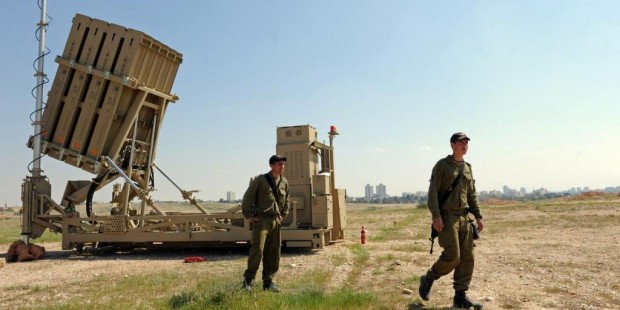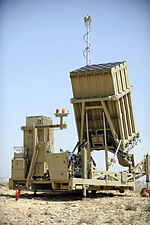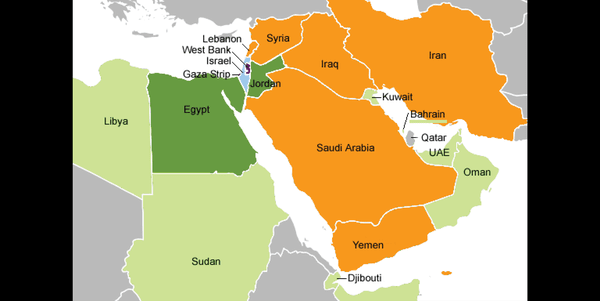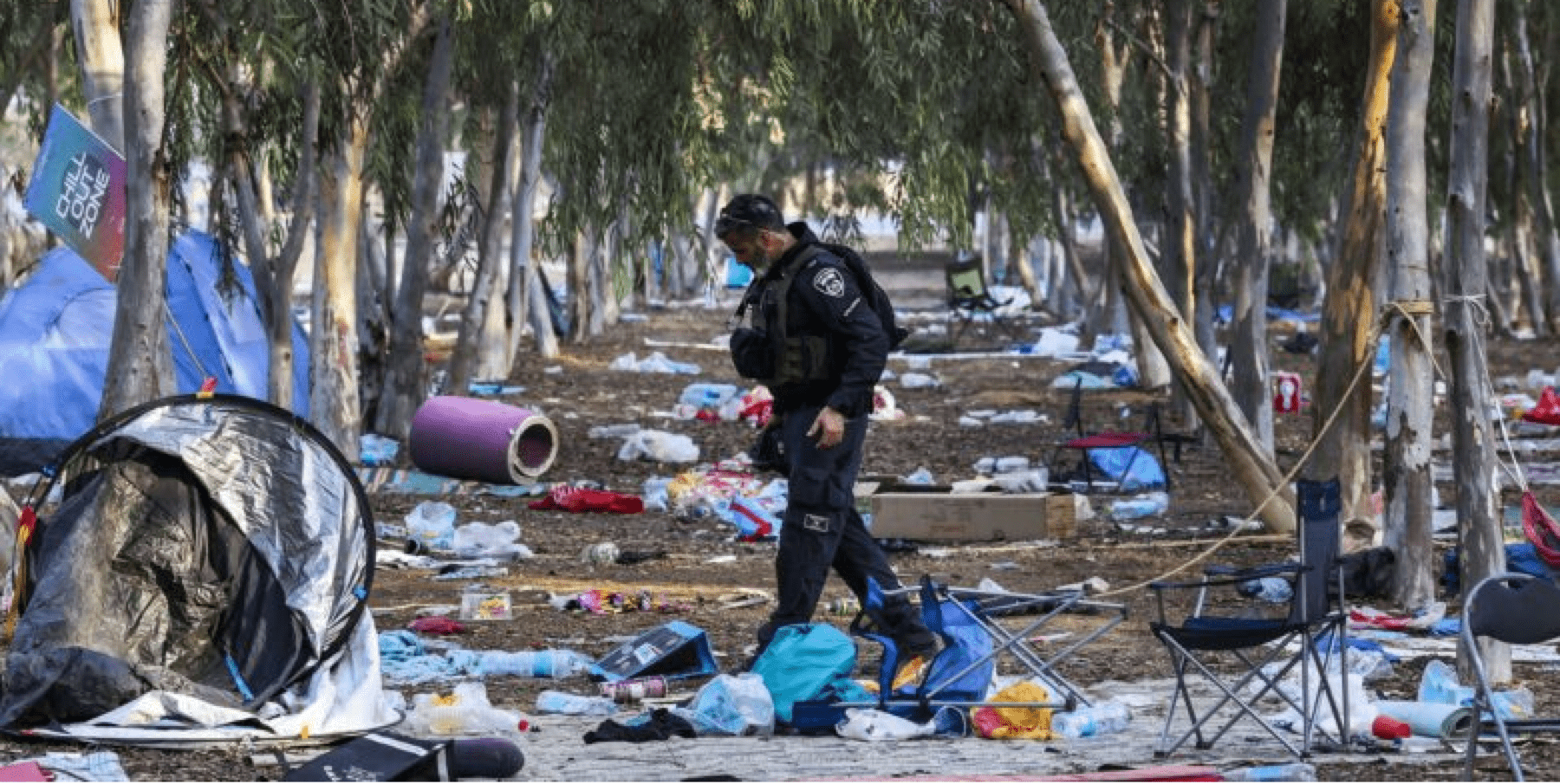Israel’s Iron Dome Missile Defense System
March 22, 2012

| Iron Dome | |
|---|---|
 “Iron Dome” launcher deployed next to Sderot, Israel (June 2011) |
|
| Type | Counter Rocket, Artillery, and Mortar |
| Place of origin | |
| Service history | |
| In service | 2011–present |
| Used by | |
| Wars | Gaza–Israel conflict (2011, 2012) |
| Production history | |
| Designer | Rafael Advanced Defense Systems |
| Designed | 2005–present |
| Manufacturer | Rafael Advanced Defense Systems |
| Unit cost | US$40,000 per missile US$50 million per battery |
| Produced | 2011–present |
| Specifications | |
| Weight | 90 kg (200 lb)[1] |
| Length | 3 m (9.8 ft)[1] |
| Diameter | 160 mm (6.3 in)[1] |
|
|
|
| Detonation mechanism |
Proximity fuze[2] |
|
|
|
| Launch platform |
Three launchers, each carrying 20 interceptors.[1] |

The radar of the Iron Dome

“Iron Dome” system intercepting ‘Grad’ rocket (January 2010 testings)
Iron Dome (Hebrew: כִּיפָּת בַּרְזֶל kipat barzel) is a mobile air defense system[2] in development by Rafael Advanced Defense Systems[1] designed to intercept and destroy short-range rockets and artillery shells fired from distances of 4 to 70 kilometers away whose trajectory would take them to a populated area, in all weather conditions.[3][4] The system, created as a defensive countermeasure to the rocket threat against Israel’s civilian population on its northern and southern borders, uses technology first used in Rafael’s SPYDER system. Iron Dome was declared operational and initially deployed on 27 March 2011 near Beersheba.[5] On 7 April 2011, the system successfully intercepted a Grad rocket launched from Gaza for the first time.[6] On 10 March 2012, The Jerusalem Post reported that the system shot down 90% of rockets launched from Gaza it fired at (rockets which will land in unpopulated areas are ignored).[4]
Background
During the 2006 Second Lebanon War, approximately 4,000 Hezbollah-fired rockets (the great majority of which were short-range Katyusha rockets) landed in northern Israel, including on Haifa, the country’s third largest city. The massive rocket barrage killed 44 Israeli civilians[7] and caused some 250,000 Israeli citizens to evacuate and relocate to other parts of Israel while an estimated 1,000,000 Israelis were confined in or near shelters during the conflict.[8]
To the south, more than 4,000 rockets and 4,000 mortar bombs were fired into Israel from Gaza between 2000 and 2008, principally by Hamas. Almost all of the rockets fired were Qassams launched by 122 mm Grad launchers smuggled into the Gaza Strip, giving longer range than other launch methods. Nearly 1,000,000 Israelis living in the south are within rocket range, posing a serious security threat to the country and its citizens.[9]
In February 2007, Defense Minister Amir Peretz selected Iron Dome as Israel’s defensive solution to this short-range rocket threat.[10] Since then, the US$210 million system has been developed by Rafael Advanced Defense Systems working jointly with the Israel Defense Forces.[11]
Specifications
The system is designed to counter short-range rockets and 155 mm artillery shells with a range of up to 70 kilometers. According to its manufacturer, Iron Dome will operate day and night, under adverse weather conditions, and can respond to multiple threats simultaneously.[12]
Iron Dome has three central components:[11][12]
- Detection & Tracking Radar: the radar system is built by Elta, an Israeli defense company
- Battle Management & Weapon Control (BMC): the control center is built by mPrest Systems, an Israeli software company, for Rafael
- Missile Firing Unit: the unit launches the Tamir interceptor missile, equipped with electro-optic sensors and several steering fins for high maneuverability. The missile is built by Rafael.
The system’s radar detects the rocket’s launch and tracks its trajectory. Then, the BMC calculates the expected hit point according to the reported data, and uses this information to determine whether the target constitutes a threat to a designated area; only in this case an interceptor missile is fired to detonate the rocket before it reaches the expected impact area.[11]
Funding
The funding and development of the Iron Dome system was provided and undertaken solely by Israel.[13] In May 2010, the White House announced that U.S. President Barack Obama would seek $205 million from U.S. Congress in his 2011 budget, to spur the production and deployment of additional Iron Dome batteries. White House spokesman Tommy Vietor stated, “The president recognizes the threat missiles and rockets fired by Hamas and Hezbollah pose to Israelis, and has therefore decided to seek funding from Congress to support the production of Israel’s short range rocket defense system called Iron Dome.” This would be the first direct U.S. investment in the project.[13] Such financial assistance could expedite the completion of the defensive system, which has long been delayed by budgetary shortfalls.[14] A few days later, on 20 May 2010, the U.S. House of Representatives approved the funding in a 410–4 vote.[15] The bill, the United States-Israel Missile Defense Cooperation and Support Act (H.R. 5327), was sponsored by Representative Glenn C. Nye of Virginia.[16] This money was expected to be included in the 2011 budget. Once the money is received in 2011, it will still take a further 18 months before the additional batteries are delivered to the air force.[17]
On 9 May 2011, Haaretz published that Defense Ministry director general Maj. Gen. (res.) Udi Shani said that Israel plans to invest nearly $1 billion in the coming years for the development and production of Iron Dome batteries. “We are no longer approaching this in terms of initial operational capabilities but are defining the final target for absorbing the systems, in terms of schedule and funds. We are talking about [having] 10–15 Iron Dome batteries. We will invest nearly $1 billion on this. This is the goal, in addition to the $205 million that the U.S. government has authorized,” Shani said.[18]
Development
Design
In 2007 Israel commissioned the development of Iron Dome, choosing Israeli contractor Rafael over the American giant Lockheed Martin. Israeli company mPrest Systems was put in charge of programming the core of Iron Dome’s battle management system. Iron Dome went from the drawing board to combat readiness within less than four years, a remarkably short period of time for a weapons system designed from scratch, according to military experts.[19]
| “ | There was no system like this, anywhere in the world, in terms of capabilities, speed, accuracy. We felt like a start-up | ” |
| —Eyal Ron, a manager at mPrest[19] | ||
Testing
- July 2008: the Tamir interceptor missile underwent successful testing.[20]
- March 2009: Israel successfully tested the missile defense system, though without yet actually intercepting an actual projectile.[21]
- July 2009: the system successfully intercepted a number of rockets mimicking Qassam and short-range Katyusha rockets in a Defense Ministry test.[22]
- August 2009: the IDF completed the establishment of a new battalion that will operate the Iron Dome system. The battalion is a part of the Israel Air Force’s Air Defense Division. The system was to be first be deployed along the Gaza border and then along the border with Lebanon. The system was slated to start operating in mid-2010.[23]
- January 2010: Iron Dome successfully intercepted multiple rocket barrages mimicking Qassams and Katyushas. Defense Ministry Director-General Pinhas Buchris stated that the system would ultimately “transform” security for the residents of southern and northern Israel.[24]
- July 2010: The system successfully intercepted multiple rocket barrages mimicking Qassams and Katyushas. During the test, Iron Dome successfully distinguished rockets which were threats from those that would not land in designated areas and did not need to be intercepted.[25]
- March 2011: Iron Dome was declared operational by the IDF, and Defense Minister Ehud Barak authorized deployment.[26][27]
During the first stage of Iron Dome’s operational duty, the Israeli Air Force included many soldiers from Sderot, citing high motivation among the city’s pre-army youth to be part of the project.[28] The 947th “Marksmen” Stinger Battalion of the Israeli Air Defense Network was chosen as the first unit to become familiar with and operate Iron Dome.[29]
Deployment
On 19 July 2010, Israel’s Defense Ministry announced that the system was ready for operational deployment in November. The system was to be initially placed at Sderot, near the Gaza Strip.[31]
In March 2011, the Israeli military said that the first deployed system, near Beer Sheva, was operational. In April, another system was deployed near Ashkelon.
On 7 April 2011, after deployment as an “operational experiment” on 3 April, the Iron Dome system in the area of Ashkelon successfully intercepted a Grad rocket fired at the city, the first time a short-range rocket fired from Gaza had been intercepted. According to reports from the area, the interception could be seen in Israeli towns near northern Gaza.[6] Immediately afterwards an IAF aircraft successfully attacked the squad that had fired the rocket. Later that day the IDF stressed that the system, though operational, was still under evaluation.[32] On 8 April the system successfully intercepted another four rockets.[33]
On 12 April, the IDF announced it would accelerate the introduction of a third Iron Dome battery. According to Haaretz, IDF officials indicated that the security establishment intended to ensure that the third battery would become available in six months, instead of the expected 18 months. According to the new plan, launchers from existing systems would be combined with other components that had already been manufactured in order to speed up the battery’s production. In that way, the first operational Iron Dome battalion would come into being within six months, with batteries that could be deployed in the south or in other arenas.[34]
Also according to Haaretz, the IDF was to finalize its long-term Iron Dome acquisition program — nicknamed “Halamish” — within a few months (from April 2011), which would indicate the final number of systems to be introduced into the military. Israel Air Force officials estimated the number of Iron Dome systems needed to cover threatened areas at thirteen.[34] According to Meir Elran, a scholar at the Institute of National Security Studies in Tel Aviv, Israel would need a total of 20 batteries to provide adequate defense for its borders with Gaza and Lebanon. Such a deployment would require financial assistance from the United States, but he said that even in the original limited form, officially designated a trial period, the system was important.[19]
On 5 August 2011 the IDF redeployed the Iron Dome system near Ashkelon following days of heightened rocket fire from Gaza into Israel. The deployment came a day after Ashkelon mayor Benny Vaknin sent Prime Minister Benjamin Netanyahu and Defense Minister Ehud Barak a letter asking them to redeploy the system.[35]
On 18 August 2011 four rockets were fired from Gaza at Ashkelon. The system determined that two were a threat and intercepted them, ignoring the other two which were directed at non-populated areas. No injuries or damage were reported. Defense officials said that Iron Dome would be re-deployed in Beersheba.[36]
On 20 August 2011, while engaging with a volley of seven rockets fired almost simultaneously at Be’er Sheva from Gaza, one was not intercepted by the defense system, exploding in a residential area and killing Yossi Shushan. Brig. Gen. Doron Gavish, commander of the IAF’s Air Defense Corps, said on the following day that “we said in advance that this wasn’t a hermetic system,” adding that the air defense units were learning on the fly and improving the performance of Iron Dome while operating it. “This is the first system of its kind anywhere in the world; it is in its first operational test; and we’ve already intercepted a large number of rockets targeting Israeli communities, saving many civilian lives,” Gavish said.[37]
On 21 August 2011 Ynetnews reported that the success of the Iron Dome system against Gazan rocket fire had southern city mayors battling over the right to be the next to have it deployed in their area. The IDF stressed that “no system can offer airtight protection” and that the system positioned in Ashkelon was incapable of extending its defense to Ashdod, but this did not stop the mayors from pressuring the Defense Ministry and the IDF to position Iron Dome batteries within their city limits. Ashdod, Ofakim, Netivot, Beersheba and Ashkelon have all pursued the system, but the IDF had only two batteries available.[38]
Also according to the report, Rafael was set to deliver a third battery no later than October 2011[dated info]. The defense establishment had decided to cover Beersheba and Ashkelon first, as they have a tangible risk of rocket fire. Three additional Iron Dome batteries are set to be supplied throughout 2012, at which time the IDF will be able to offer other southern communities better protection. Israel’s north and center would have to remain unprotected.[38]
On the same day, The Jerusalem Post reported that Defense Minister Ehud Barak announced that a third Iron Dome battery would be installed in the region “within weeks”, and estimated that nine more batteries would be positioned within the next two years.[39] In attacks shortly before, the Iron Dome system had successfully intercepted about 85% of the rockets[clarification needed] launched at Israel from Gaza.[40]
On 23 August 2011 Globes reported that Rafael would invest tens of millions of shekels in the following months to open a second production line for the Iron Dome’s Tamir interceptor missiles. Future operational needs, as well as the plan to build two more Iron Dome batteries by the end of the year, necessitated the increase of missile production.[41]
On 31 August 2011 the IAF deployed a third Iron Dome battery outside Ashdod, two days[42] after Defense Minister Ehud Barak said that it would take an additional 10 days for it to be delivered. Barak praised the IDF Chief of Staff Benny Gantz, the IAF Air Defense Division and the security establishment for beating the deadline and beginning the deployment before the opening of the school year.[43][44] On 1 December 2011 Brig. Gen. Gavish said that a fourth battery of the system would be deployed in the “coming months”. He spoke to the Jerusalem Post ahead of the Air Defense Division’s largest-ever draft of soldiers needed to fill the ranks of its increasing number of units and battalions. “The numbers will continue to grow and another battery will become operational in the beginning of the year,” he said.[45] On 8 December, “outstanding” officer Capt. Roytal Ozen began to command the battery’s unit in preparation for its deployment, the first woman to be in charge of the system.[46]
On 6 December 2011 Matan Vilnai, the Israeli Minister of Home Front Defense, said that the Defense Ministry is considering a permanent deployment of an Iron Dome battery in the Haifa Port to protect the oil refineries there against future Hezbollah rocket attacks. “The continued work of the oil refineries is critical for the Israeli economy during a time of war,” he said. During the Second Lebanon War in 2006, a number of Katyusha rockets struck Haifa but did not hit the refineries. A direct hit on one of the refineries may cause numerous casualties as a result of leakage of dangerous chemical substances. The port is also the site of a chemical terminal that includes containers of ammonia and ethylene gas.[47][48]
On 30 December 2011 the Jerusalem Post reported that a performance analysis it had obtained shows that Iron Dome was successful in downing rockets from Gaza 75% of the times it fired. It said two interceptors are usually fired at each rocket. In April 2011, for example, the system succeeded in intercepting 8 of 10 rockets; in August 22 of 28, and in October 3 of 9. Following the October violence, the IDF conducted an inquiry into the Iron Dome’s performance and discovered that a radar failure caused some of the interceptors to miss their targets, a problem since corrected. An officer told the Post that “seventy-five percent is impressive, but we would still like to see it perform better.”[49]
On 10 March 2012 the “Jerusalem Post” reported that the performance of Iron Dome has improved to over 90%, as it had successfully shot down a total of 27 rockets over the cities of Ashdod, Ashkelon, Beersheba. The system correctly ignored rockets heading towards unpopulated fields. [50]
Response by Palestinian militants

Iron Dome launcher deployed near Ashkelon
On 22 August 2011 Haaretz reported that according to Israeli security sources Palestinian militants had changed their rocket-launch tactics in an attempt to evade the two Iron Dome batteries deployed in southern Israel. The new tactics included aiming more frequently at areas beyond the Iron Dome protection range. After the Palestinian launch teams realized that the systems deployed in the previous two weeks around Ashkelon and Be’er Sheva provided near-perfect protection from rockets, they began firing more frequently at Ashdod and Ofakim. When they did aim at Be’er Sheva on 21 August, they did not fire one or two rockets, as in the past, but rather a volley of seven rockets almost simultaneously. Iron Dome intercepted five of them successfully, but one penetrated the defense system, exploding in a residential area and killing a man.[37]
2011 Supreme Court decision
On 8 August 2011 the Israeli High Court of Justice rejected a petition asking that the government be ordered to deploy the system in Gaza border communities. In rejecting the petition, Supreme Court President Dorit Beinisch and Justices Salim Joubran and Uzi Fogelman ruled that in balancing all relevant considerations including budgets, changing security realities and operational matters, the government’s decision not to deploy the Iron Dome in the area was reasonable. The panel of justices also said that the court had no reason to intervene in operational decisions regarding where to deploy the Iron Dome system. “We believe the [government] will make the necessary decisions in accordance with the time and place requirements,” they said.[51]
In its petition, the Eshkol Regional Council argued that the government should be ordered to deploy the Iron Dome to protect communities between 4.5 and 7 kilometers from Gaza from rocket fire. Government-funded rocket-roof protection is in place for homes in communities within 4.5 km of Gaza, but not for structures further from the border.[51]
The state said that the High Court should not intervene in the “military decision” regarding how and where to deploy the anti-rocket system. It also argued that if the court were to order it to deploy Iron Dome in a specific area, budgetary limitations would result in other communities not receiving protection, particularly as the range of Palestinian rockets had grown in recent years and therefore it was not possible to deploy Iron Dome to protect every community.[51]
December 2011 accident
On 26 December 2011 an accident occurred during a maintenance drill involving one of the systems. While loading missiles into a launcher vehicle from a bunker at the Air Defense Network’s school near kibbutz Mashabei Sadeh in the Negev,[52] Twenty Tamir interceptors fell from a height of four meters near soldiers and officers without detonating, causing no injury, but making them unserviceable.[53][54] Ynetnews reported that the soldiers were never in danger because the interceptor missiles are equipped with a security mechanism that prevents premature explosions. The IDF Spokesperson’s Unit said that the Air Force commander, Maj. Gen. Ido Nehushtan, appointed a committee to examine the accident and ordered an immediate stop to all Air Defense Network maintenance work until a preliminary investigation was concluded.[54] It also said that during the following week actions would be taken to “improve skills and safety awareness”.[53][52] A security official told Reshet Bet that the failure was twofold in that that the soldiers and their commander deviated from severely strict safety protocols, and 20 costly interceptors were lost.[53] Walla! website reported that the soldiers made a mistake in loading the missiles and they fell backwards. The website calculated the damage at a million USD (at $50,000 per missile), and reported that the missiles were transferred back to Rafael to determine whether they could be repaired.[52]
On 1 January 2012 two soldiers were sentenced to punishment by the school’s commanding officer following an inquiry into their conduct regarding the incident. The lieutenant in charge of the loading crew was given 21 days in military prison, while the sergeant in charge of the technician crew was given 14 days.[55]
March 2012 intensive attacks
Foreign sales
 NATO
NATO- On 10 March 2010, The Jerusalem Post reported that the Israeli Ministry of Defense was in talks with a number of European countries about the possible sale of the system in order to protect NATO forces deployed in Afghanistan and Iraq.[59]
 South Korea
South Korea- During a visit to Israel in the summer of 2011, Kwon Oh-bong, vice commissioner of the Defense Acquisition Program Administration in Seoul, expressed interest in purchasing the system in order to counter the threat posed by North Korean artillery, rockets, and missiles.[60]
 United States
United States- On 16 August 2011, Raytheon Company announced that it had teamed with Rafael in order to lead marketing in the United States for the Iron Dome system. “Iron Dome complements other Raytheon weapons that provide intercept capabilities to the US Army’s Counter Rocket, Artillery, and Mortar initiative at forward operating bases,” said Mike Booen, vice president of Raytheon Missile Systems’ Advanced Security and Directed Energy Systems product line. “Iron Dome can be seamlessly integrated with Raytheon’s C-RAM systems to complete the layered defense.”[61]
- On 10 November 2011 the Jerusalem Post reported that the US Army had expressed interest in acquiring the system, to be deployed outside forward bases in Iraq and Afghanistan that could potentially be targeted by Katyusha rockets. The US military had discovered 107 mm Katyushas in Iraq in the past.[62] On 1 December 2011 the Jerusalem Post reported that the US Army would decide in January 2012[dated info] whether it would purchase the system. Yossi Druker, head of Rafael’s Air-to-Air Directorate, said that the initial deal is valued at $100 million, but could reach several hundred million dollars over a number of years.[63]
Criticism
In 2010, Iron Dome was criticized by Reuven Pedatzur, a military analyst, former fighter pilot and professor of political science at Tel Aviv University[64] for costing too much compared to the cost of a Qassam rocket, so that launching very large numbers of Qassams could essentially attack Israel’s financial means.[65] The estimated cost of each Tamir interceptor missile is US$35,000–50,000[11] whereas a crudely manufactured Qassam rocket costs around $800.[66] Rafael responded that the cost issue was exaggerated since Iron Dome intercepts only rockets determined to constitute a threat, and that the lives saved and the strategic impact are worth the cost.[67]
Iron Dome has been criticized as ineffective in countering the Qassam threat for the southern city of Sderot, given the short distance and flight time between the much-attacked city and the rocket launching pads in the Gaza Strip.[65][68] Other anti-rocket systems, such as the Nautilus laser defense system, were argued to be more effective. From 1995 to 2005 the United States and Israel jointly developed Nautilus but scrapped the system after concluding it was not feasible, having spent $600 million. The US Navy continued R&D on the system. American defense company Northrop Grumman proposed developing a more advanced prototype of Nautilus, Skyguard.[68] Skyguard would use laser beams to intercept rockets, with each beam discharge costing an estimated $1,000–$2,000. With an investment of $180 million, Northrop Grumman claims it could possibly deploy the system within 18 months. Israeli defense officials have rejected the proposal, citing the extended timeline and additional costs. Officials also insist that with recent improvements to Iron Dome, the system is fully able to intercept Qassams.[68][69]
References
- ^ a b c d e Ben-David, Alon (18 March 2008). “Iron Dome advances to meet Qassam threat”. Jane’s. http://www.janes.com/products/janes/defence-security-report.aspx?ID=1065927116&pu=1&rd=janes_com#. Retrieved 18 August 2011.
- ^ a b “Iron Dome Air Defense Missile System, Israel”. army-technology.com. http://www.army-technology.com/projects/irondomeairdefencemi/. Retrieved 18 August 2011.
- ^ Sharp, Jeremy M. (16 September 2010). “U.S. Foreign Aid to Israel”. Congressional Research Service. http://www.fas.org/sgp/crs/mideast/RL33222.pdf. Retrieved 18 August 2011.
- ^ a b Katz, Yaakov (10 March 2012). “Iron Dome ups its interception rate to over 90%”. The Jerusalem Post. http://www.jpost.com/Defense/Article.aspx?id=261257. Retrieved 10 March 2012.
- ^ “Israel deploys ‘Iron Dome’ rocket shield”. Al Jazeera English. 27 March 2011. http://english.aljazeera.net/news/middleeast/2011/03/201132718224159699.html. Retrieved 18 August 2011.
- ^ a b Pfeffer, Anshel; Yanir Yagna (7 April 2011). “Iron Dome successfully intercepts Gaza rocket for first time”. Haaretz. http://www.haaretz.com/news/diplomacy-defense/iron-dome-successfully-intercepts-gaza-rocket-for-first-time-1.354696. Retrieved 7 April 2011.
- ^ “Israel-Hizbullah conflict: Victims of rocket attacks and IDF casualties”. Israeli Ministry of Foreign Affairs. http://www.mfa.gov.il/MFA/Terrorism-+Obstacle+to+Peace/Terrorism+from+Lebanon-+Hizbullah/Israel-Hizbullah+conflict-+Victims+of+rocket+attacks+and+IDF+casualties+July-Aug+2006.htm. Retrieved 21 August 2009.
- ^ Rubin, Uzi (June 2007). “The Rocket Campaign against Israel during the 2006 Lebanon War”. The Begin-Sadat Center for Strategic Studies. http://www.biu.ac.il/SOC/besa/docs/MSPS71.pdf. Retrieved 15 August 2009.
- ^ “Summary of rocket fire and mortar shelling in 2008”. Intelligence and Terrorism Information Center. 1 January 2009. http://www.terrorism-info.org.il/malam_multimedia/English/eng_n/pdf/ipc_e007.pdf. Retrieved 21 August 2009.
- ^ “Defense Minister selects Rafael anti-missile defense system”. Haaretz. 4 February 2007. http://www.haaretz.com/hasen/spages/820967.html. Retrieved 4 August 2009.
- ^ a b c d “Israel successfully tests “Iron Dome” rocket & artillery shell defence system”. defpro.com. 27 March 2009. http://www.defpro.com/daily/details/277/. Retrieved 4 August 2009.
- ^ a b “Iron Dome: Defense System Against Short Range Artillery Rockets”. Rafael Advanced Defense Systems. http://www.rafael.co.il/marketing/SIP_STORAGE/FILES/6/946.pdf. Retrieved 6 August 2009.
- ^ a b Entous, Adam; Caren Bohan (13 May 2010). “Obama seeks $205 million for Israel rocket shield”. Reuters. http://www.reuters.com/article/idUSTRE64C5JO20100513?type=politicsNews.
- ^ Amos Harel (13 May 2010). “Iron Dome defense system gets new backer: Barack Obama”. Haaretz. http://www.haaretz.com/news/diplomacy-defense/iron-dome-defense-system-gets-new-backer-barack-obama-1.290226.
- ^ JPost.com staff and Hilary Leila Krieger (21 May 2010). “US approves $205m. for Iron Dome”. The Jerusalem Post. http://www.jpost.com/Israel/Article.aspx?id=176072.
- ^ “United States-Israel Missile Defense Cooperation and Support Act”. Library of Congress. http://thomas.loc.gov/cgi-bin/bdquery/z?d111:h.r.05327:. Retrieved 21 May 2010.
- ^ Katz, Yaakov; JPost.com Staff (04/10/2011). “IDF conditionally ceases air strikes on Hamas targets”. The Jerusalem Post. http://www.jpost.com/Defense/Article.aspx?id=216028.
- ^ Harel, Amos (9 May 2011). “Israel to invest $1 billion in Iron Dome missile defense system”. Haaretz. http://www.haaretz.com/print-edition/news/israel-to-invest-1-billion-in-iron-dome-missile-defense-system-1.360610. Retrieved 9 May 2011.
- ^ a b c “New Israeli anti-missile system sees success in Gaza, altering war against rockets”. The Washington Post. Associated Press. 10 April 2011. http://www.washingtonpost.com/world/new-israeli-anti-missile-system-sees-success-in-gaza-altering-war-against-rockets/2011/04/10/AFu7uIGD_story.html. Retrieved 13 April 2011.
- ^ “Israeli arms company successfully tests Iron Dome anti-Qassam missile”. Haaretz. 7 July 2008. http://www.haaretz.com/hasen/spages/999680.html. Retrieved 27 July 2009.
- ^ “Israel successfully tests anti-rocket system”. The Guardian. 27 March 2009. http://www.guardian.co.uk/world/feedarticle/8425672. Retrieved 24 August 2009.
- ^ “Iron Dome system successful in tests”. The Jerusalem Post. 16 July 2009. http://fr.jpost.com/servlet/Satellite?pagename=JPost/JPArticle/ShowFull&cid=1246443820017. Retrieved 27 July 2009.
- ^ “IDF moves one step closer to getting Iron Dome”. The Jerusalem Post. 23 August 2009. http://fr.jpost.com/servlet/Satellite?pagename=JPost/JPArticle/ShowFull&cid=1249418679065. Retrieved 24 August 2009.
- ^ “Israel to deploy Gaza rocket interceptor by June”. The Jerusalem Post. 6 January 2010. http://fr.jpost.com/servlet/Satellite?cid=1262339412240&pagename=JPost/JPArticle/ShowFull. Retrieved 7 January 2010.
- ^ Katz, Yaakov, “Iron Dome Successfully Intercepts Kassam, Katyusha Barrages”, The Jerusalem Post, July 15, 2010, p. 2.
- ^ “Vilnai: Israel has strategic reason not to use Iron Dome”. The Jerusalem Post. 24 March 2011. http://www.jpost.com/Defense/Article.aspx?id=213580&pagename=JPost/JPArticle/ShowFull. Retrieved 25 March 2011.
- ^ a b “Barak confirms: ‘Iron Dome’ to be deployed within days”. The Jerusalem Post. 25 March 2011. http://www.jpost.com/Defense/Article.aspx?id=213848&pagename=JPost/JPArticle/ShowFull. Retrieved 25 March 2011.
- ^ Sarusi, Neta (21 August 2009). “Boulevards (Sderot) of Defense”. Bamahane (3001): p. 12. (Hebrew)
- ^ Sarusi, Neta (16 October 2009). “”The Marksmen” Don an Iron Dome”. Bamahane (3008): p. 18. (Hebrew)
- ^ Harel, Amos (3 February 2010). “IDF: No plans to deploy anti-missile system in Sderot”. Haaretz. http://haaretz.com/hasen/spages/1147188.html. Retrieved 3 February 2010.
- ^ Associated Press, “Israel: Anti-Rocket System Is Ready For Deployment”, The New York Times, 20 July 2010.
- ^ “”Iron Dome” Intercepts Rocket From Gaza”. IDF Blog. Israel Defense Forces. 7 April 2011. http://idfspokesperson.com/2011/04/07/iron-dome-intercepts-rocket-from-gaza/. Retrieved 7 April 2011.
- ^ Issacharoff, Avi (8 April 2010). “IDF strikes kill nine in Gaza as barrage of mortars hits Israel”. Haaretz. http://www.haaretz.com/news/diplomacy-defense/idf-strikes-kill-nine-in-gaza-as-barrage-of-mortars-hits-israel-1.354827. Retrieved 8 April 2010.
- ^ a b Yagna, Yanir; Anshel Pfeffer (12 April 2011). “Israel speeds up third Iron Dome battery in wake of Gaza attacks”. Haaretz. http://www.haaretz.com/news/diplomacy-defense/israel-speeds-up-third-iron-dome-battery-in-wake-of-gaza-attacks-1.355578. Retrieved 12 April 2011.
- ^ Harel, Amos; Avi Issacharoff (5 August 2011). “IDF redeploys Iron Dome as rocket fire from Gaza increases”. Haaretz. http://www.haaretz.com/news/diplomacy-defense/idf-redeploys-iron-dome-as-rocket-fire-from-gaza-increases-1.377153. Retrieved 5 August 2011.
- ^ Curiel, Ilana; Shmulik Hadad; Abigail Looshi (18 August 2011). “Iron Dome intercepts 2 rockets fired at Israel”. Ynetnews. http://www.ynetnews.com/articles/0,7340,L-4110902,00.html. Retrieved 18 August 2011.
- ^ a b Pfeffer, Anshel (22 August 2011). “Israeli defense sources: Gaza terror groups change tactics to avoid Iron Dome system”. Haaretz. http://www.haaretz.com/print-edition/news/israeli-defense-sources-gaza-terror-groups-changing-tactics-to-avoid-iron-dome-system-1.379914. Retrieved 22 August 2011.
- ^ a b Yehoshua, Yossi (21 August 2011). “Municipalities ‘battle’ over Iron Dome”. Ynetnews. http://www.ynetnews.com/articles/0,7340,L-4111602,00.html. Retrieved 21 August 2011.
- ^ JPost.com Staff (21 August 2011). “Barak: IDF won’t tolerate rocket attacks from Gaza”. The Jerusalem Post. http://www.jpost.com/Defense/Article.aspx?id=234777. Retrieved 21 August 2011.
- ^ Lake, Eli, “Missile Defense Scores Political Hits”, The Washington Times, 30 August 2011, p. 9.
- ^ Azoulai, Yuval (23 August 2011). “Rafael to double Iron Dome production”. Globes. http://www.globes.co.il/serveen/globes/docview.asp?did=1000676140. Retrieved 25 August 2011.
- ^ Katz, Yaakov (30 August 2011). “Third Iron Dome battery to be deployed near Ashdod”. The Jerusalem Post. http://www.jpost.com/Defense/Article.aspx?id=235923. Retrieved 1 September 2011.
- ^ Katz, Yaakov (31 August 2011). “IAF deploys third Iron Dome battery outside Ashdod”. The Jerusalem Post. http://www.jpost.com/Defense/Article.aspx?id=236177. Retrieved 1 September 2011.
- ^ Hadad, Shmulik (31 August 2011). “Iron Dome system deployed in Ashdod”. Ynetnews. http://www.ynetnews.com/articles/0,7340,L-4116302,00.html. Retrieved 1 September 2011.
- ^ Katz, Yaakov (1 December 2011). “IAF chief: 4th Iron Dome battery to be deployed soon”. The Jerusalem Post. http://www.jpost.com/Defense/Article.aspx?id=247686. Retrieved 4 December 2011.
- ^ Buhbut, Amir (8 December 2011). “שילוב נשים בצה”ל: קצינה תפקד על סוללת כיפת ברזל [Integration of women in the IDF: female officer to command on an Iron Dome battery]” (in Hebrew). Walla!. http://news.walla.co.il/?w=/2689/1883515. Retrieved 8 December 2011.
- ^ Katz, Yaakov (6 December 2011). “Defense Ministry mulls permanent Haifa Iron Dome”. The Jerusalem Post. http://www.jpost.com/MiddleEast/Article.aspx?id=248350. Retrieved 6 December 2011.
- ^ Zitun, Yoav (6 December 2011). “Gov’t mulling Iron Dome system in Haifa”. Ynetnews. http://www.ynetnews.com/articles/0,7340,L-4157872,00.html. Retrieved 6 December 2011.
- ^ Katz, Yaakov (30 December 2011). “Iron Dome successful in downing 75% of rockets”. The Jerusalem Post. http://www.jpost.com/Defense/Article.aspx?id=251535. Retrieved 1 January 2012.
- ^ Katz, Yaakov. “Iron Dome ups its interception rate to over 90%”. The Jerusalem Post. http://www.jpost.com/Defense/Article.aspx?id=261257. Retrieved 12 March 2012.
- ^ a b c Paraszczuk, Joanna (9 August 2011). “Petition rejected to deploy Iron Dome near border towns”. The Jerusalem Post. http://www.jpost.com/Defense/Article.aspx?id=233003. Retrieved 10 August 2011.
- ^ a b c Amir Buhbut; Walla News Staff (29 December 2011). “בשל רשלנות: נזק של מיליון דולר למערכת כיפת ברזל [Due to negligence: million dollar damage to Iron Dome system]” (in Hebrew). Walla!. http://news.walla.co.il/?w=/2689/1889405. Retrieved 29 December 2011.
- ^ a b c Menashe, Carmela (29 December 2011). “תקלה חמורה ב”כיפת ברזל” [Serious malfunction at “Iron Dome”]” (in Hebrew). Kol Yisrael Radio website. http://www.iba.org.il/bet/bet.aspx?type=1&entity=810419. Retrieved 29 December 2011.
- ^ a b Ben-Yishai, Ron (29 December 2011). “Iron Dome missiles damaged” (in Hebrew). Ynetnews. http://www.ynetnews.com/articles/0,7340,L-4168485,00.html. Retrieved 29 December 2011.
- ^ Ziton, Yoav (2 January 2012). “נפילת טילי כיפת ברזל: עונשי מחבוש לקצין ולנגדת [Fall of Iron Dome missiles: Mahbosh sentence for officer and NCO]” (in Hebrew). Ynetnews. http://www.ynet.co.il/articles/0,7340,L-4169945,00.html. Retrieved 2 January 2012.
- ^ Haaretz: IDF strike in Gaza kills leader of Popular Resistance Committees
- ^ http://www.idf.il/1086-15196-EN/Dover.aspx
- ^ http://www.idf.il/1086-15253-EN/Dover.aspx
- ^ Katz, Yaakov (10 March 2010). “NATO forces interested in Iron Dome”. The Jerusalem Post. http://www.jpost.com/Israel/Article.aspx?id=170605. Retrieved 18 August 2011.
- ^ Etsion, Udi (19 June 2011). “S. Korea eyes Iron Dome system”. Ynetnews. http://www.ynetnews.com/articles/0,7340,L-4083719,00.html. Retrieved 19 August 2011.
- ^ “Raytheon Teams with Rafael to Market Iron Dome Weapon System” (Press release). Raytheon Company. 16 August 2011. http://raytheon.mediaroom.com/index.php?s=43&item=1892. Retrieved 19 August 2011.
- ^ Katz, Yaakov (10 November 2011). “US may purchase Iron Dome batteries”. The Jerusalem Post. http://www.jpost.com/Defense/Article.aspx?id=245031. Retrieved 16 November 2011.
- ^ Katz, Yaakov (1 December 2011). “US may buy Iron Dome to defend ME bases”. The Jerusalem Post. http://www.jpost.com/Defense/Article.aspx?id=247684. Retrieved 4 December 2011.
- ^ Fox, Stuart (30 March 2011). “Iron Dome: Israel Deploys Unique, Controversial Missile System”. msnbc.com. http://www.msnbc.msn.com/id/42348984/ns/technology_and_science-science/t/iron-dome-israel-deploys-unique-controversial-missile-system/#.Tkx70ajIiuI. Retrieved 18 August 2011.
- ^ a b “Iron Dome does not answer threats”. The Jerusalem Post. 9 May 2010. http://www.jpost.com/Israel/Article.aspx?id=175042. Retrieved 26 May 2010.
- ^ “What are Qassam Rockets?”. Jewish Policy Center. http://www.jewishpolicycenter.org/prr/qassams.php. Retrieved 9 August 2009. “The raw materials for one rocket can cost up to $800.”
- ^ “Iron Dome rocket defense system will be operational by 2010”. Haaretz. 10 April 2009. http://www.haaretz.com/hasen/spages/1077622.html. Retrieved 9 August 2009.
- ^ a b c “Israel to offer Iron Dome system to US”. The Jerusalem Post. 13 March 2008. http://fr.jpost.com/servlet/Satellite?cid=1205261316940&pagename=JPost/JPArticle/ShowFull. Retrieved 9 August 2009.
- ^ “Iron Dome system found to be helpless against Qassams”. Haaretz. 22 February 2008. http://www.haaretz.com/hasen/spages/956859.html. Retrieved 9 August 2009.
Similar posts
-

Israel Has The Most Moral Military In The World
April 10, 2024In the heart of a region often riddled with conflict, Israel stands out not only for its technologi...
-

The Resilience of the Israeli People
April 2, 2024Visitors from around the world have seen Hamas's October 7th Massacre's destruction in southern Isr...
-

Israel: Small Size, Big Impact
March 21, 2024Nestled along the eastern edge of the Mediterranean Sea, Israel is a land of immense historical sig...
-

Israelis Are Fighting For Their Lives
February 21, 2024By Jonathan S. Tobin The world looks a lot different from Kibbutz Kfar Aza than it does in the U...
-

Over 2 Million Arabs Live In Israel
January 23, 2024In the complex landscape of the Middle East, where diverse cultures and identities intersect, Israe...
-

'Fauda' Star Idan Amedi Injured Fighting in Gaza
January 8, 2024Despite the severity of his injuries, Amedi's father assured Israeli news channels that his life is...
-

Israel Is A Great Country To Live In
December 28, 2023Nestled at the crossroads of the Middle East, Israel stands as a vibrant and dynamic nation, offeri...
-

Dear World: I Don't Care
November 2, 2023By Avi Lewis I don’t care that you sympathize with Hamas I know you wouldn’t tolerate any of ...




















